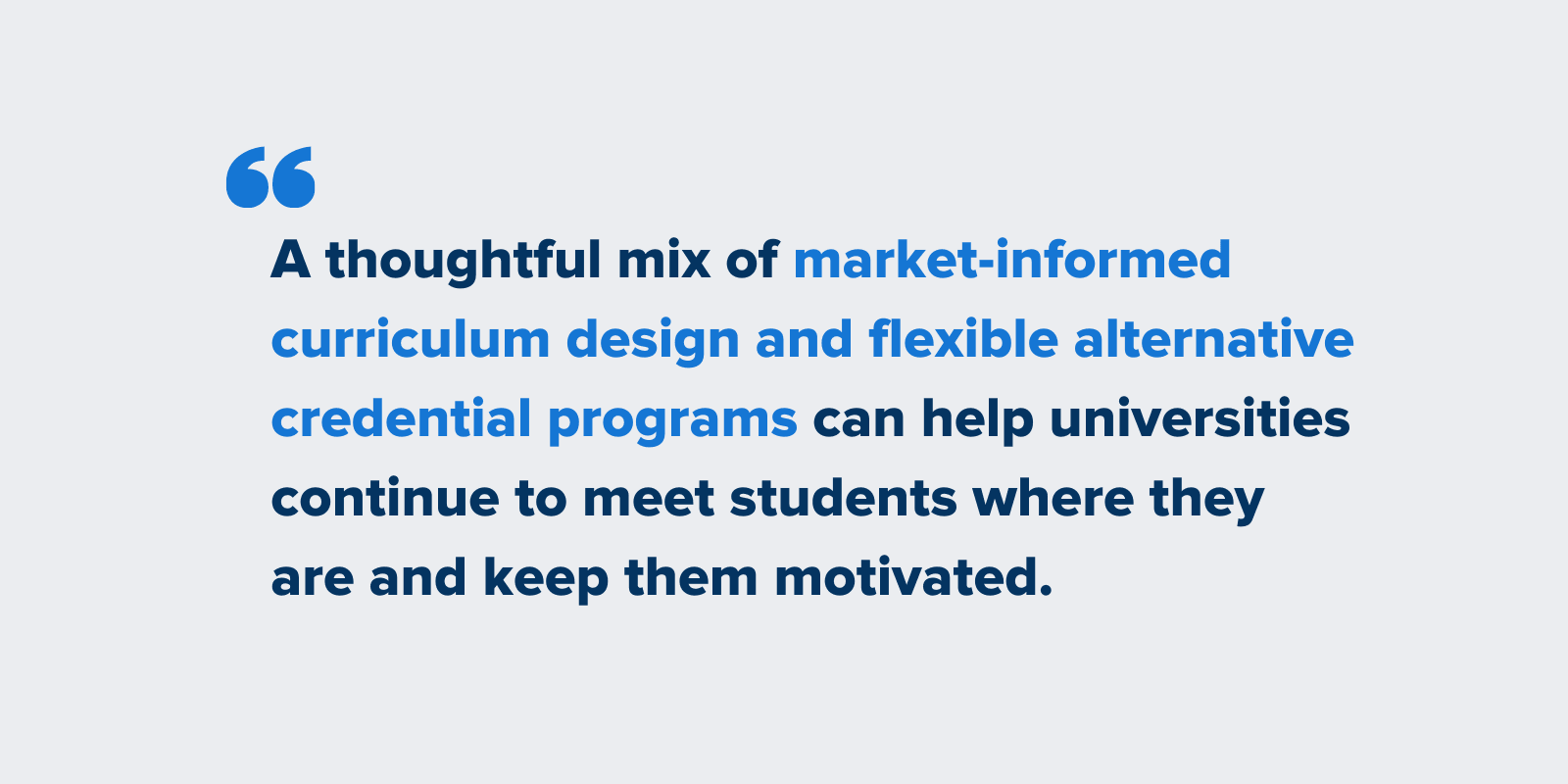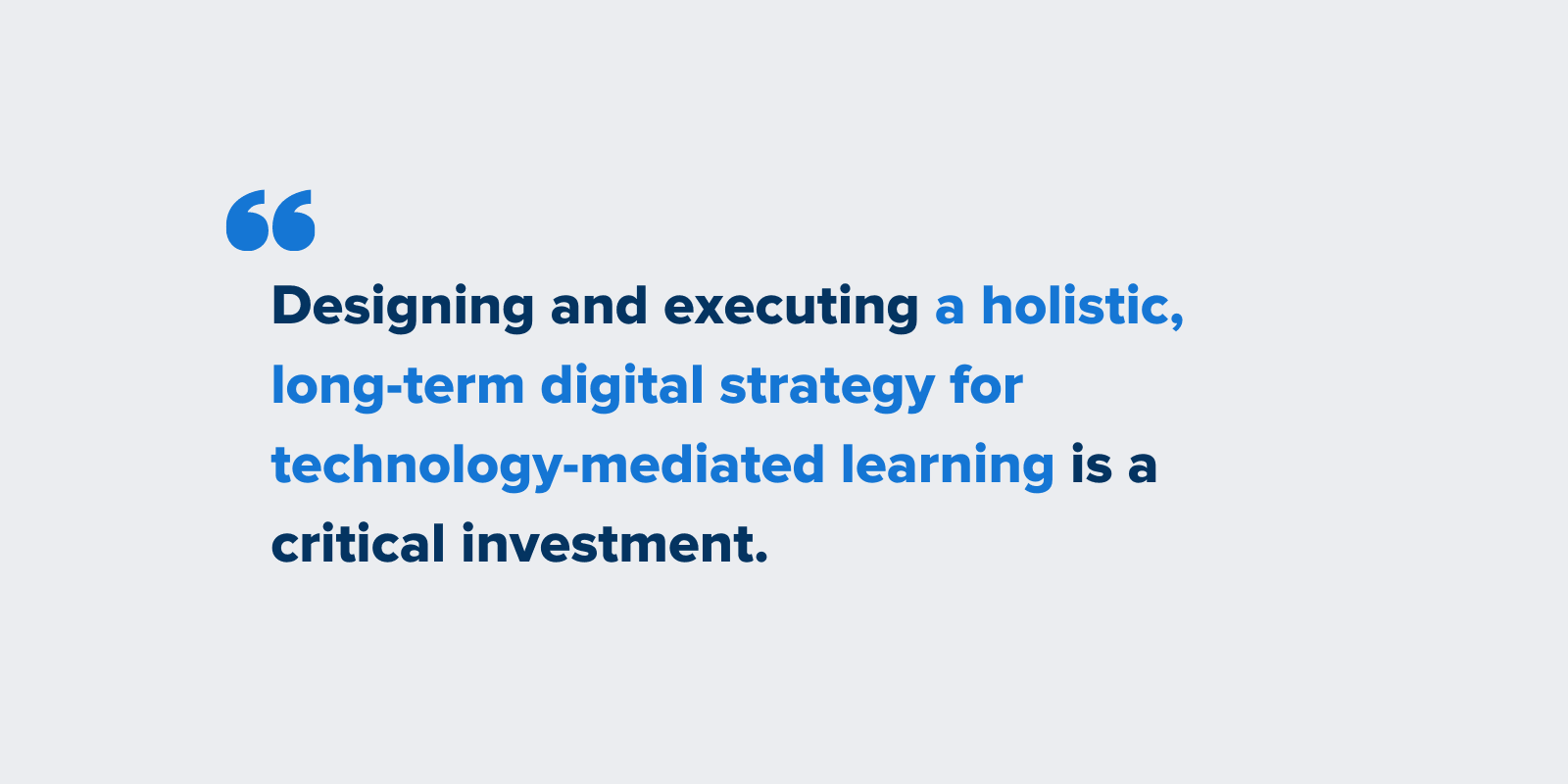Insights
4 Digital Transformation Pillars to Help Universities Embrace Change and Accelerate Innovation
Written by Nathan Greeno on Dec 15, 2021
Related content: Digital Education

Higher education is facing a new normal. Institutions that were initially structured to rally against rapid change by anchoring society in historic principles are now being asked to do something they’re not natively designed to do: adapt fast. Globally across our partners, 2U sees how universities are overcoming turbulence in a pandemic world. They are investing in designing long-term, comprehensive approaches to digital education that go beyond offering “remote learning” in order to accelerate the innovation curve and survive in the current and future competitive landscape.
Earlier this year, I made the case for why a digital transformation strategy is an imperative for universities, now more than ever. On a recent keynote panel for this year’s European Foundation for Management Development (EFMD) Global Annual Conference, I offered my perspective on how universities can embrace this imperative in a way that minimizes risk, maximizes opportunity, and meets student needs, market demand, and institutional sustainability. To an international audience of leaders from the worlds of education, business, and management development, I proposed that universities can best prepare for the future by developing an intentional digital strategy founded upon four core pillars.
1. High Quality
Universities have done a masterful job of teaching learners face-to-face; it’s their hallmark and their legacy. But today’s new normal compels universities to examine how they can still achieve great outcomes but apply different, more future-forward inputs. Higher education is at the forefront of gathering and implementing the latest in learning science. Universities are actively in the process of determining how students learn differently online, and what those “a-ha” cues and measures of success are, so that they can purposefully design curriculum for online learning experiences that drive the same quality student outcomes that they’ve achieved on the ground. The burning question is, can higher education turn these inputs on their side with different toolsets and pedagogies—and with a more thoughtful and precise balance of synchronous and asynchronous content—to drive that same level of success?
To determine the answer, I encourage universities to spend substantive time honing in on a conclusive definition of what quality means to them, such that they can continue to deliver the same caliber of education their students have come to expect, just through new technology-driven modes, modalities, and media.

2. Relevance
For universities to remain relevant in the future, their educational offerings must not only align more closely to market demand, but also prepare a more diverse range of learners for the jobs of tomorrow, not just the jobs of today. A thoughtful mix of market-informed curriculum design and flexible alternative credential programs, built upon the concept of stackability and interoperability, can help universities continue to meet students where they are and keep them motivated and engaged as lifelong learners.
2U’s work with UNC’s Kenan-Flager Business School to develop a Python elective course for its MBA students is a powerful example of curriculum design inspired by specific skill set needs of the market. When UNC offered this course on the increasingly in-demand programming language, enrollment hit capacity in less than one hour. MicroBachelors and MicroMasters, now offered by 2U through the edX platform, are great examples of stackability and interoperability. These microcredential programs enable learners to get their feet wet and complete individual courses on their own time, which can later be applied toward an accelerated undergraduate or graduate degree. Developing a broader portfolio of customizable learning opportunities—like 2U’s offerings that range from free to degree and everything in between—can help support individuals’ learning journeys at any stage in their lives.
3. Blended and Connected Learning
Hybrid learning models that combine the best of virtual and in-person experiences can help universities extend their mission and reach, and in ways that help ensure the accessibility and affordability of their offerings for as many learners as possible. While there are plenty of students who enjoy the flexibility of online learning, that doesn’t necessarily mean they’re not eager or available to participate in immersive experiences on campus.
At 2U, we see students taking advantage of these short-term, concentrated, in-person learning and networking opportunities in record numbers. Offering a hybrid format lets prospective students know up front that they don’t have to pick up their lives and move in order to experience a high-quality education. Layering immersive experience options into a program also lets them know they have multiple opportunities to develop close-knit, long-lasting connections to their peers, faculty, and learning ecosystem overall.

4. Sustainability
In the face of rising expenses and shrinking budgets across higher education, universities need to make sure they’re setting themselves up for a more sustainable future. This equates to developing programs that create stronger, more affordable outcomes for students and that also provide long-term financial stability for institutions.
There are admittedly plenty of semantics around the cost of corporate-academic partnerships, but at 2U, we focus on total cost of acquisition, or TCA. Some universities have the capacity to drive costs down related to successful student marketing and recruitment, but many others do not. When our partners show interest in reaching beyond their existing acquisition channel set, 2U uses deep market insights and data to help them itemize all resources to unlock the true surplus, drive it to the bottom line, and extend it back into even more impactful acquisition strategies and relevant curriculum design.
A Critical Investment
Across higher education, there are several structural challenges to innovation—internal governance frameworks, programmatic accreditation, and faculty reward systems, to name a few. But in today’s new normal, if universities don’t innovate fast enough, then a vacuum is created, and other competitors will inevitably step in to fill learners’ needs. For universities that wish to continue driving financial sustainability and deliver best-in-class student experiences for the future, designing and executing a holistic, long-term digital strategy for technology-mediated learning is a critical investment.
Latest.
Learn more about us.
At 2U, we’re on a mission—to eliminate the back row in higher education and help partners thrive in the digital age. To learn more about who we are and what we do, follow the links below.